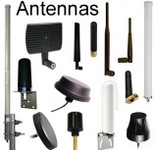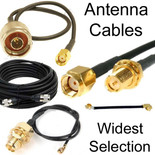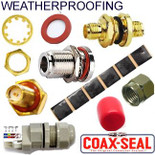Antennas, Antenna Cables, Wireless Products: Technical Articles
Wireless / WiFi for Boats and Marinas
Ubiquiti Bullet versions compared (w/ details for Boat or RV)
- BulletM2 Titanium has much the same radio specs as the BulletM2HP plus it has extreme weatherproofing and comes with a POE 24 volt (see footnote)
- For BulletM2HP you would have to buy the POE separately.
- Bullet M5 and Bullet5 are 5GHz-spectrum devices and thus not right for a boat unless you are connecting to 5GHz hotspots (which is unlikely because 5GHz hotspots are very rare, though occasionally found in marinas)
- BulletM2 is the BulletM2HP - there is no non-HP version of BulletM2 BulletM2HP is the same price as B2HP, an older version that does not have MIMO (wireless-N aka 802.11n): So might as well buy BulletM2HP.
- DC barrel adapter with lead wire, to connect POE injector to your 12-volt system
- POE injector
- The Bullet Titanium will run on 12 volts. The 24 volt POE is offered b/c some voltage is lost in long cable runs 100ft
Marina: WiFi hotspot open-access: "How to" w/ map-diagram
Use RocketM2, combined with this sector antenna: AM2G15& - these are both Ubiquiti products. Install the RocketM2 and antenna at the position of the ISP link.
The sector antenna has 120-degrees radiation pattern so you just face it toward the middle of the marina. The sector antenna is better to use than an omni-directional antenna (in most cases, as in this case), because the ISP connection is on one side of the marina and the antenna can be aimed to cover the entire hotspot-area.The power to the rocket is power over ethernet (POE) and the POE is included. The ethernet cable is not included. We have many options - click here - depending on what length you need.
QUESTION: Any problem with tide issue on low tide there is approx.10-12 drop and line of site would be compromised? Should I be also putting Access Point on b and c. sorry about picture but that is where cement wall is and at low it would be out of line of site.
ANSWER: The rocket and antenna combo that I recommended is very strong and I don't think you will need additional access points, and I think it will cover fine even at low tide. I suggest that you try it - installed at the position of the ISP link - and see how the coverage is. MULTIPLE APs with ROAMING among them: The UAP series is the best solution if you need to install multiple APs and enable roaming among them, on the same SSID and security keys: The UAPOUTDOOR 2.4GHz has exactly the same form factor as the RocketM2 and so it will mount inside the same antennas that the RocketM2 mounts into - for example sector antenna: AM2G15 
Boat WiFi: List of parts to install USB WiFi adapter on mast & R36 repeater/router inside cabin
- SKU R36: Alfa R36 Router for AWUS036H & other, Create hotspot / Access Point. Wireless Bridge / Repeater
- SKU CU5: Alfa AWUS036H 1000mW USB Wireless WiFi Adapter + Antenna. Long-Range
- SKU U10: USB 2.0 Active Repeater Extension Cable: 10 meters / 33-ft: Chain up to 25 meters / 80FT
- SKU A8oM: Antenna: Marine Waterproof 8dBi Omni-Directional Stainless Steel
- SKU: ENC2: Outdoor Enclosure / Mount for Alfa AWUS036H AWUS036NH & Antenna: Fits all small WiFi USB adapters
- SKU P4: Antenna cable: RP-SMA male to N male: 10-inch
- SKU SG: Waterproof Seal for Electrical & USB Connections: Silicone Grease, Clear, Never Hardens
The cost for all of the above items is $127.43 + shipping (as of March 2013)
HOW THIS SYSTEM WORKS:
- The "remote" signal - a WiFi signal that has an internet connection - is picked up by the Alfa WiFi adapter
- The Alfa WiFi adapter plugs into the R36 by USB cable
- The R36 then acts as a local access point - re-broadcasting that signal locally (such as in a boat).
- Then the local users can connect to the R36's WiFi signal
R36 power on boat / yacht or RV
If a boat/yacht has electricity converted to 110v then it would work to plug-in to the existing power sockets.Some of our yachters tie the electricity into the 12-volt battery power supply that is native for the boat. The details of this are beyond what I could write you in a simple email - it takes a little expertise to do that but am amateur can do it with a little research.
Customer wrote:
"Hi George - Need some advice, when it comes to power supplies on the boats & yachts for the R36 - will the power supply that is issued with the R36 need a converter or inverter to be used on a boat Will the power supply plug directly into an power socket on a boat and work? Any advice would really be appreciated"
Bandwidth bottlenecks in RV park or Marina
QUESTIONS from a customer: The WiFi connection utility says I have 54 megabits, but downloads are too slow. Yes the AP may offer 54 megabits and my connection utility says 54 megabits but try this approach. Try to simultaneously watch your connection speed while at the same time downloading a large file or a complicated webpage. You can watch the connection speed drop dramatically. You may actually have 54 megabits if you are the only person using the AP. Often you are not. In the mobile home/RV park where I live, on busy weekends I may have a high indicated connection speed but repeatedly get a "cannot find the server at xyz.com". The AP is overloaded with traffic from other users.
Another and related issue is connection speed versus actual download speed. I can connect at 11 or 54 megabits, but my measured download speed is no more than 480 kilobits due to the pipe feeding the AP which is giving all of us to share only part of a single T1 line!!!
ANSWERS:
Re: the AP: I think they need to upgrade to a professional-grade AP.
Re: The final issue that you mentioned: The internet connection is typically the bottleneck in any such scenario, since the LAN/WiFi bandwidth is much greater. The solution resides in upgrading the internet connection, of course.
Boat / marine power 12-volts POE injector
Boats are generally 12v and they do not want to run their 110/220v inverters all the time. One customer is cutting the cat5e cable and taking the 2 power pairs out, then the clients can wire directly into the boats power supply. One customer is using our POE injectors. He joins a female 5.5/2.1mm power jack, then attaches a male jack connected to the 12v boat system. The male jack will also connect to the POE injectorMarinas & Boats: Range experiences etc.
Observations of one of our customers who sails the Caribbean:
The equipment on shore certainly makes a BIG difference in the range we can get (which certainly must have to do with the RX and TX ability of the access point). For instance, there is a pay internet service down here that has decent equipment (most people/bars/restaurants down here don’t). This service wants to be able to allow just your laptop to connect from you boat. Some people it works OK for, others not. Probably limited by the TX of the individual laptop card I would bet (as you described). With the we have been able to connect to this service from about 4 (nautical) miles offshore. With less fancy equipment being used onshore (a belkin or Linksys home access point), we might get about a mile, but that’s about it. So, I would think that both the RX and TX are important, unless you know the access point is so powerful, in that case, I would agree the TX of the USB card would be the limiting factor. Out here in the boating world, we try to connect to anything we can basically, and have no control over what’s on shore, so my feeling is anything that can help the RX is going to make a difference also, but probably only a side by side test would be able to prove it.
Wireless Bridge for boating
This solution is becoming more popular. High-end bridges were first introduced for marine applications in about 2005. For a couple of years, these solutions cost upwards of USD 2000, essentially limiting them to the super yachts. By now they have come down in price significantly. See Ubiquiti solutions on data-alliance.netNote: See Ubiquiti Picostation 2 HP: $90, has transmit power of 800mW, is very small, and has the RP-SMA fitting that allows antennae to be switched. In addition, it can be take 5-24V input power. It also has well developed software.
Pros:
1) These units have fairly powerful and sensitive transceivers (400mW).
2) Different antennas can be attached and used as the situation calls for
3) The antennas are close to the transceiver
4) These are somewhat modular systems where transceiver cards, and antennas can be upgraded over time. (To upgrade the cards one needs to be fairly technically competent).
5) Bridges can often double as Access Points, meaning that multiple PCs can share the same connection to the shore.
6) Most of these units are weatherproof.
Cons:
1) Antenna positioning: Whilst these systems can accommodate directional antenna(s), one still has to get to the antenna to aim it. A permanent installation high up a pole may make it difficult to aim the antenna…
2) Power: These systems can draw 3A of power and/or require 110V, 48V, or 24V. Read the manuals to verify the input power requirements. Ideally one powers them directly off the onboard 12V system.
3) Ease of use: Configuring and maintaining these systems requires extra skills and attention to detail that go beyond what most cruisers have. We know of two boats that threw them out because they were too cumbersome to administer.
There are cheap off the shelf WIFI Bridges (e.g. Linksys WET54G). The transceivers contained within them have lower power and sensitivity than is optimal on board use. In addition their software isn’t optimized for on board use. Stay away from them!
Summary:
Bridges have come down in price and are becoming more attractive. However, we think a bridge is overkill for most users. In addition, a permanent install seems (somewhat) at odds with a directional antenna, which in our experience is so important for increased range. We had a system like this on Bravado. We found it performed worse than the “Bravado solution” described below. Later we met with a super yacht that had a top of the line Syrens system. Again, we could see substantially more Access Points than they could. If you really want a permanently installed system, a bridge indeed is the way to go. However, using just an omni-directional antenna means a significant performance hit. Other people also report that a modular USB solution yields better results.
Laptop's Internal WIFI card is not enough for boating life
This is the basic configuration most boats have: A laptop with an internal WIFI transceiver and antenna.
Pros:
- Low cost: It comes standard with most PCs.
- Flexible: One can take the laptop ashore and establish a WIFI connection in many Internet cafes, marina/yacht club lobbies etc.
- Ease of use: Most users are very familiar with this solution form their home/office experience.
Cons:
- Power: Too low (typically 200mW or lower)
- Sensitivity: Too low (<90dB)
- Antenna: Built in antennae are intended for short-range communications. They offer low gain (e.g. <3dB) and cannot be positioned/directed independently of the laptop.
Summary:
If you are reading this document, chances are that you have this setup, yet find it wanting. It works well in an office/internet café setting. However, aboard a boat this solution starts letting you down once the distance from the Access Point increases. At an anchorage you would be lucky to get any connection at all.
This article written by: Ewoute Mante
Boats: Antennas & positioning
This is the basic configuration most boats have: A laptop with an internal WIFI transceiver and antenna.
The importance of the WiFi antenna is often overlooked. Many yachtsmen just use the antenna their system came with. The capability of an antenna to boost a signal is expressed in decibels (dB). An off the shelf short “stubby” antenna will typically provide a 3dB gain. As with the sensitivity, each 3dB step provides a doubling of the range. Additional gain can be achieved either by going to higher quality antennae, or by focusing the signal. In the latter case, rather than transmitting and receiving in a full circle as with the “omni-directional” antennae, one can opt to focus the radio beam into a narrower segment using some form of “directional” antenna. Think of this as adding a reflector to the back of a lamp. More of the available light/radio energy is directed into a specific direction. For our dialogue restricting the available energy into a 120-degree arc significantly increases the range.
Boats are not a very stable platform. At anchor they can swing through a large arc due to tide, wind, and wakes. In port (or at a quiet anchorage) the motion is much more limited.
Our customer Ewoute Mante (the author of this article): wrote: 95% of the time we used a directional antenna that covers a 120 degree arc and boosts the signal by 15dB. We found that narrower directional beams cause too much signal interruption when the boat moves and thus looses alignment with the shore-based Access Point. It is perhaps 5% of the time that we use the omni-directional antenna. We take it out when the boat swings too much for the directional antenna to remain locked into an Access Point. The omni-directional antenna has a shorter range and thus shows fewer APs.

Marine-grade omni-directional antenna: SKU A8oM
The positioning of the Antenna is very important: Anybody that has used a traditional AM/FM radio will know that rotating a radio just a couple of degrees or moving it relative to large metal objects can have a dramatic effect on reception (and similarly transmission). Ewoute Mante (article author): We typically have the antenna inside the boat, which makes it easy to aim the directional antenna when we arrive in a new port. Usually, on arrival we do a quick scan by rotating the antenna over a 30-degree arc, checking what Access Points we see. We repeat this step until we have completed a full circle. The entire process usually takes less than 2 minutes. Under marginal conditions (i.e. when we failed to pick up a good signal), we usually move the antenna on deck, or even attach it to a boathook that we point up through a hatch and then rotate to aim the antenna in the required direction. This is a pretty rare occasion.
The omni-directional antenna also usually starts it “work” below decks and only moves above decks when the need becomes apparent. We added a special loop at the top, that allows us to suspend that antenna from the boom or if need be a halyard.
We do not like permanent installations for three reasons:
- Most permanent installations imply a fixed antenna positioning
- A permanent installation requires a marine grade solution. Not only does it make the unit itself more expensive, the combined cost of fittings, cables, glands etc. all add up.
- WIFI is a fast moving field. Take heed from the lessons of cellular phones: In the late 90s some boats added masthead antennae for their cellular phones and docking stations at considerable expense. Most of that technology became obsolete very quickly.
WiFi solutions for boats, yachts, marinas
One of our customers wrote this article about how to choose and how much money to spend on a WiFi solution: This article is aimed at the layman rather than umber-geek. Some very low cost solutions exist that can significantly improve the on board WIFI experience. Rather than spend money on paid WIFI sites, we would recommend investing in some very simple technology that should outperform just about anything out there. You will recoup the investment by having cheaper Internet access. We recommend using cheap off the shelf solutions that are flexible. Do not over invest in expensive high-end (marine grade) gear. It will quickly be outdated and doesn’t seem to give the best performance.
The recommended:
- Relatively cheap (Costs approximately USD 125).
- Performs extremely well (better than USD 2500 solutions).
- Is flexible (individual components can be upgraded over time as better solutions become available).
- Easy to install also for novices. (No need to drill holes your boat!)
- Works with Mac, Windows (XP and Vista) and Linux.









